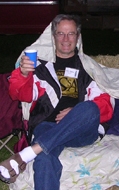
Home » Journal Articles » Thoughts & Opinions » Terry’s Tips – Mar/Apr 2006
 Cans of compressed air, like for computer dusting, are a good solution for cleaning surfaces prior to waxing or gluing, or cleaning out holes. Keep your powered sander or polisher moving: overheating the stone can cause an aggravating milky effect in it. The sandblasting class last year at Silver Falls by Lisa Ponder came in handy. A light treatment produced a nice satin finish on a piece of slate. It also cleaned up the natural surface I wanted to preserve of a piece of soapstone. Make sure your base is ready when the last polishing is complete on the sculpture. Last minute modifications to the assembly can be avoided if the “final image” has been scoped out. It can also allow the finished piece to be moved to a safe haven, rather than kicking around the studio awaiting a base.
Cans of compressed air, like for computer dusting, are a good solution for cleaning surfaces prior to waxing or gluing, or cleaning out holes. Keep your powered sander or polisher moving: overheating the stone can cause an aggravating milky effect in it. The sandblasting class last year at Silver Falls by Lisa Ponder came in handy. A light treatment produced a nice satin finish on a piece of slate. It also cleaned up the natural surface I wanted to preserve of a piece of soapstone. Make sure your base is ready when the last polishing is complete on the sculpture. Last minute modifications to the assembly can be avoided if the “final image” has been scoped out. It can also allow the finished piece to be moved to a safe haven, rather than kicking around the studio awaiting a base.
As a protective measure contact paper can be used to help protect a finished surface. I seem to be able to scratch almost any piece just by looking at it. The current issue of Sculptural Pursuit has an interesting article on Styrofoam modeling for light-weight full-size maquettes. If the big blocks aren’t readily available, construction insulating sheets can be glued together. Tracy Powell’s show in Bellingham was quite impressive: three days of hauling sculptures from home to gallery.
Various gleanings from my readings: sorry, but all aren’t identified. “Life isn’t a support system for art. It’s the other way around” (Steven King). “You can’t evolve unless you’re involved” (somebody famous). “Background music shrinks the vastness of the threatening world” (me). “To conceive an idea is noble, to execute the work is servile” (somebody else famous). “When in doubt, go hell-for-stout” (Ron Aksamit). “If the scratches aren’t gone by 200 grit, they’re not going away with the 400 grit” (me).









We need some kind of descriptive text here.